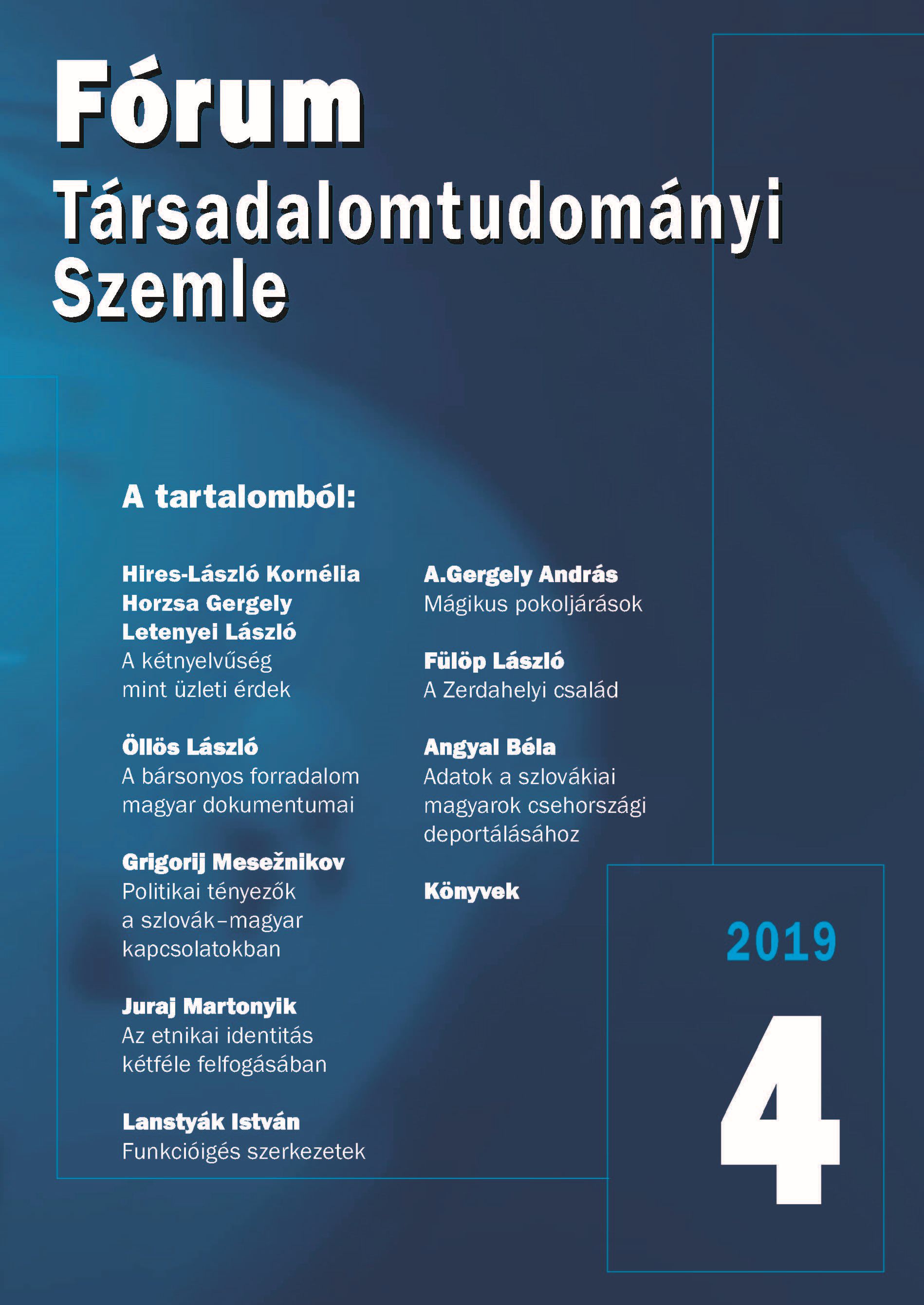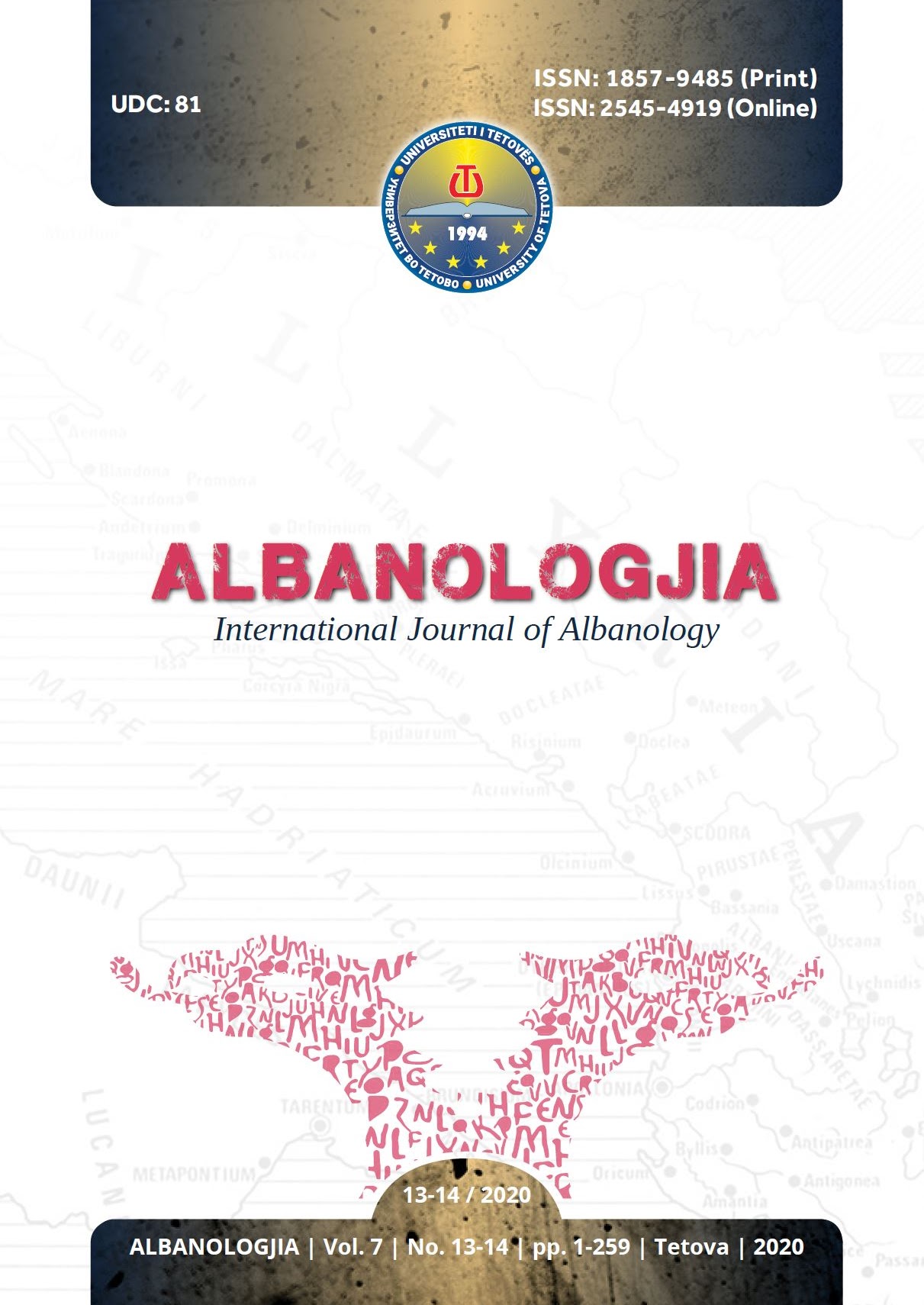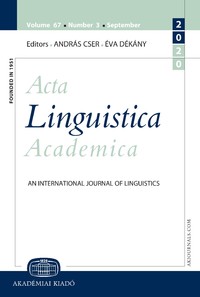We kindly inform you that, as long as the subject affiliation of our 300.000+ articles is in progress, you might get unsufficient or no results on your third level or second level search. In this case, please broaden your search criteria.
Straipsnyje pristatomi šnekamosios kalbos tyrimo, atlikto Vytauto Didžiojo universitete, naudojantis sakytinės lietuvių kalbos tekstyno duomenų baze, rezultatai. Gauti rezultatai lyginami su lietuvių kalbos gramatikose (dabartinės lietuvių kalbos, funkcinėje ir praktinėje) pateikiama klausiamųjų sakinių sistema.
More...
This paper examines light verb constructions, with special regard to the borderline cases, i.e. verbo-nominal constructions, which may or may not be analyzed as light verb constructions. It analyses the possible meanings of the light verbs—beyond being the carriers of grammatical functions, and compares them with the meanings of the potential or actual one-word equivalents of these constructions. The empirical basis of the research is provided by the v2.0.5 of the Hungarian National Corpus.
More...
This paper deals with the syntax of the direct speech particle in Hittite, particularly its inconsistent use within direct speech. It is suggested that a syntactic account of what appears at first sight as an entirely chaotic distribution is possible.
More...
András Kertész, Edith Moravcsik & Csilla Rákosi (eds.). (2019) Current approaches to syntax. A comparative handbook. Comparative Handbooks of Linguistics 3. Berlin–Boston: Walter De Gruyter. xvi + 600 pp
More...
András Kertész, Edith Moravcsik & Csilla Rákosi (eds.). (2019) Current approaches to syntax. A comparative handbook. Comparative Handbooks of Linguistics 3. Berlin–Boston: De Gruyter Mouton. xvi + 600 pp
More...
The work analyzes the position, contact and distance in cognitive terms. The difference bitweena position and a part of a sentence is presented. The proof of this is sought in examples with the same word order and token presentation, but with different syntactic relations.A new syntactic category is substantated - cognitive code.The work analyzes the position, contact and distance in cognitive terms. The difference bitweena position and a part of a sentence is presented. The proof of this is sought in examples with the same word order and token presentation, but with different syntactic relations.A new syntactic category is substantated - cognitive code. The work analyzes the position, contact and distance in cognitive terms. The difference bitweena position and a part of a sentence is presented. The proof of this is sought in examples with the same word order and token presentation, but with different syntactic relations.A new syntactic category is substantated - cognitive code. The work analyzes the position, contact and distance in cognitive terms. The difference bitweena position and a part of a sentence is presented. The proof of this is sought in examples with the same word order and token presentation, but with different syntactic relations.A new syntactic category is substantated - cognitive code. The work analyzes the position, contact and distance in cognitive terms. The difference bitweena position and a part of a sentence is presented. The proof of this is sought in examples with the same word order and token presentation, but with different syntactic relations.A new syntactic category is substantated - cognitive code. The work analyzes the position, contact and distance in cognitive terms. The difference bitweena position and a part of a sentence is presented. The proof of this is sought in examples with the same word order and token presentation, but with different syntactic relations.A new syntactic category is substantated - cognitive code.
More...

Reviewing Minimalist Theories of Control and a Brief Look at Romanian Control. The phenomenon of control is a long-discussed topic within the enterprise of generative grammar. Multiple theories were composed and dismissed along with the advancement of the module, and with the development of the Minimalist program, more recent theories on control came to surface. The present article provides a review of two minimalist theories of control: the Movement Theory of Control and the Agree Model of Obligatory Control. A synopsis of one applied model of the MTC on Romanian data is also part of the paper, as is a brief commentary on the structure of Romanian control, namely an exploration of the tension between subjunctive and infinitive control complements.
More...
This paper explores the syntactic structure of verbal gapping in Serbian in the framework of the generative theoretical approach and the ways in which this type of ellipsis differs in Serbian and English. I test analyses proposed in the literature, and explore three basic questions: 1) Is verbal gapping based on the operation of movement or deletion?; 2) Can sentences in which the verb is gapped in both conjuncts, but is recoverable based on the previous sentence (discourse antecedent), be considered examples of gapping? and3) Where is the coordination of the two conjuncts in the syntactic tree?Reasons why examples with a discourse antecedent should be considered examples of gapping include obligatory syntactic parallelism, recoverability of the verb and their existence in many unrelated languages. Analyses explored in the paper ( Johnson 2009, Coppock 2001), which assume that gapping involves a low coordination of vPs fail to generate these sentences or explain interpretations of gapping examples in which coordination scopes over negations of the conjuncts. Data points to the conclusion that Serbian gapping is not a coordination of vPs, but TPs, and that deletionis a necessary part of the derivation process. I demonstrate that Gengel’s(2007) approach, based on contrastive focus and deletion, can be applied to Serbian and explain the relevant facts.
More...
This paper considers the NP vs. DP debate from the perspective of dependency grammar (DG). The message is delivered that given DG assumptions about sentence structure, the traditional NP-analysis of nominal groups is preferable over the DP-analysis. The debate is also considered from the perspective of phrase structure grammar (PSG). While many of the issues discussed here do not directly support NP over DP given PSG assumptions, some do. More importantly, one has to accept the widespread presence of null determiner heads for the DP analysis to be plausible on PSG assumptions. The argument developed at length here is that the traditional NP-analysis of nominal groups is both more accurate and simpler than the DP-analysis, in part because it does not rely on the frequent occurrence of null determiners.
More...
Witkoś Jacek , Dominika Dziubała-Szrejbrowska , Piotr Cegłowski and Paulina Łęska . (2018). The syntax of numeral noun constructions: A view from Polish (Crossroads and Interfaces: Studies in Linguistics and Literature 40). Frankfurt am Main: Peter Lang. viii + 190 pp.
More...
This paper presents an analysis of the Russian declension in Nanosyntax (Starke 2009, 2018). The analysis has two theoretically important aspects. First, it makes no reference to language-particular declension features. This allows one to maintain the idea that morphosyntactic features are drawn from a set provided by the UG, i.e., language invariant. The analysis also does not use contextual rules. In order to correctly pair the right ending with a particular root, the analysis only relies on specifying each marker for the features it spells out. The correct pairing of roots and affixes falls out from such a specification and the Nanosyntax model of spellout.
More...
We focused in this paper on some possible difficulties related to phrase analysis. There are situations when the semantic value is essential for the right segmentation; some syntactical elements can have multiple values and lead to possible ambiguities at the level of subordinate clauses; textual connectors represent the essential link between the fragments of a text and they do not belong to the subordinate clause. The incorrect segmentation of a phrase can also have consequences at the level of the subordinate clauses.
More...

The present study deals with the role of lexical and grammatical text coherence devices in the text-constructing process and in maintaining chronological organization of the text. These devices safeguard against the disruption of the continuum in the elliptical fragmentary narrative of a Nobel Prize-winning author Toni Morrison’s short novel “Sula” where the narration weaves forward and backward, departing from the linear chronological sequence of events. “Sula” (1973) is one of the first black feminist novels in the United States, due to the current social movements sparkling a renewed interest in the story. The author herself described it as a “cracked mirror”, the pieces of which should be assembled by the reader. Methodology of the research is based on qualitative approach, the main methods being descriptive, analytical and structural-narratological. The analysis of the whole text corpus of the novel is followed by the description of the obtained data, highlighting predominant temporal devices employed in retrospection, prospection and the deixis of the narration, the continuum of narration and the overall structuring of the plot. The paper describes in detail recurrent integrative devices related to the chronological organization of the text - deictic center, specific verb tense usage, time adverbials and the overall semantics of the situation. The study shall contribute to the development of specific aspects of chronological organization of the text in the general theory of text linguistics and could be a feasible aid in teaching practical literary analysis and creative writing by providing inventory of the temporal coordinates and by developing learners’ skills for the analysis and reconstruction of the fragmented text continuum.
More...